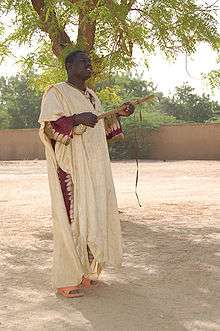Xalam
Xalam (in Serer, or khalam in Wolof) is a traditional stringed musical instrument from West Africa. The xalam is thought to have originated from modern-day Mali, but some believe that, in antiquity, the instrument may have originated from Ancient Egypt. Many believe that it is an ancestor to the African American banjo.
The xalam is commonly played in Mali, Gambia, Senegal, Niger, Northern Nigeria, Northern Ghana, Burkina Faso, Mauritania, and Western Sahara; it, and its variants, are also known in other languages as bappe, diassare, hoddu (Pulaar), koliko (Gurunsi), kologo (Frafra),[1] komsa, kontigi, gurmi, garaya (Hausa), koni, konting (Mandinka), molo (Songhay/Zarma), ndere, ngoni (Bambara), and tidinit (Hassaniyya and Berber).
In Wolof, who plays the xalam is called a xalamkat (a word composed of the verbal form of xalam, meaning "to play the xalam", and the agentive suffix -kat, thus meaning "one who xalams"). In Mande, this is ngonifola or konting fola. In Hausa, this is mai gurmi or mai kontigi.
Construction and tuning
The xalam, in its standard form, is a simple lute chordophone with one to five strings. The wooden body (soundbox) membranophone of the instrument is oval-shaped and covered with the hide of cattle. The strings of the xalam are typically made of two or three tightly wound strands of low-gauge nylon fishing line; these strings are fixed to the instrument's wooden neck by long and narrow leather strips and to its wooden bridge by cotton strings. By moving these strips, the instrument's tune can be adjusted. The xalam usually has two main melody strings that are fingered by the left hand (like the strings of a guitar or banjo) and two to three supplementary strings of fixed pitch. Most xalam players construct their own xalams, although they usually call on woodworkers (lawbe) to carve the body, neck, and bridge for them.
In most Wolof-speaking parts of Senegal, the xalam has three principal tunings, all of which involve tuning the two main strings a perfect fourth apart. In the first tuning (ci suuf or low), the main strings are tuned 1 and 4 ( 1 being the fundamental of a major scale), with three supplementary strings being tuned an octave higher to 1´, 2´, and 3´. The second tuning (ci kow or high) uses the same string intervals but the fundamental is placed a minor second above the higher melody string, meaning that the open main strings now play the role of 3 and 6, with the supplementary strings acting as 3´ and 4#, the highest supplementary string usually being ignored. In the third tuning (ardin), the fundamental is a minor third above the lowest main string and the main strings are tuned 6 and 2, with supplementary strings tuned to 5 and 1´. The third supplementary string is either ignored or is tuned to 6 or 2´. If playing in an ensemble, the ardin xalam's main strings are tuned a minor third below the cu suuf xalam, and the ci kow xalam is tuned a major third above the ci suuf xalam to ensure that the fundamentals of each xalam coincide. (Thus, if the ci suuf xalam's lowest note were C, the ardins lowest note would be a low A and the ci kow xalam's lowest note would be E.)
Players
In most areas the xalam is played by male griots, or praise singers who are born into the profession. It most often acts as a solo or duo instrument to accompany praise songs and historical recitations, and in some areas it may form part of a larger group including kora, drums, and calebashes. It is traditionally heard at weddings, infant naming ceremonies, and (always with amplification) is now a common member of folklore ensembles, popular mbalax groups, and ndaga variety shows.
Important past and present Senegalese xalam masters include Sàmba Jabare Sàmb, Ama Njaay Sàmb, Abdulaay Naar Sàmb (all from the Jolof), Abdulaay Soose (from the Saalum), and Bokunta Njaay (from the Bawol). From the Gambia, its best include the late Doudou Nying Kuli Yande and Alhaji Sait Camara. The best known Malian ngoni players are Banzumana Sissoko, Bassekou Kouyate, Mama Sissoko, Moriba Koïta, Sayan Sissoko, and Fuseini Kouyate. Among the Hausa people, the best known kontigi, komsa, and gurmi players are Dan Maraya Jos, Musa Gumel, Babangida Mai Gurmi, and Salamatu Mai Gurmi.
See also
- Akonting
- Cheick Hamala Diabate
- Kora (instrument)
- Ngoni (instrument)
- Rubab (instrument)
References
- Guttman, Yoav. "What is a Kologo?". Archived from the original on 2016-03-04. Retrieved 2012-06-17.
External links
| Wikimedia Commons has media related to Xalam (instrument). |
- Cosaan: Senegalese Culture—Xalam and Virtual Xalam
- Video of Cheick Hamala Diabate performances from Kennedy Center Millennium Stage site
